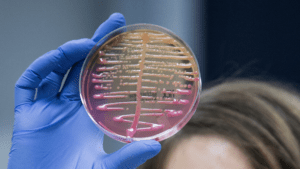TAG: GS 3: SCIENCE AND TECHNOLOGY
THE CONTEXT: The unprecedented challenges of the COVID-19 pandemic brought reverse transcriptase (RT) to the forefront of molecular diagnostics.
EXPLANATION:
- This enzyme, known for its ability to convert RNA into DNA, became essential for developing diagnostic tests for the SARS-CoV-2 virus.
- It is playing a crucial role in surveillance, public healthcare, and vaccine development.
Reverse Transcriptase
- Reverse transcriptase was independently discovered by researchers in the laboratories of Howard Temin and David Baltimore in 1970.
- Their groundbreaking work, published in Nature, challenged the Central Dogma of molecular biology, which posited that genetic information flows only from DNA to RNA to protein.
- They demonstrated that RNA could be reverse-transcribed into DNA, thus transforming the field of molecular biology.
- The editor of Nature coined the term “reverse transcriptase” in an article discussing this significant advance.

A researcher holds up a plate showing a growth of Klebsiella pneumoniae bacteria from a positive blood culture
Impact on Molecular Biology and Diagnostics
- The discovery of reverse transcriptase revolutionized research methods.
- Researchers could now reverse-transcribe messenger RNAs into DNA, clone these DNA segments into bacterial vectors, and study gene functions.
- Clinicians used reverse transcriptase to convert viral RNA into DNA, enabling accurate estimation of viral loads in diagnostic tests.
- This technique became pivotal in studying RNA viruses such as hepatitis B and HIV.
Role in HIV Management
- The discovery of reverse transcriptase significantly impacted HIV management.
- Antiviral agents targeting reverse transcriptase transformed HIV from a deadly disease into a manageable condition.
- It improves long-term outcomes for people living with AIDS.
- Studies on the enzyme provided insights into viral replication mechanisms, further advancing HIV treatment.
Retroelements and Human Genome Evolution
- Reverse transcriptases have played a crucial role in shaping the human genome.
- Human DNA contains sequences, known as retroelements, that likely originated from retroviruses through horizontal gene transfer.
- Initially considered “junk” DNA, recent evidence suggests these retroelements profoundly impact human biology and evolution.
- A study in Nature Communications linked the expression of endogenous retroviruses to neuropsychiatric disease risks, indicating their physiological significance.
Bacterial Reverse Transcriptases and Genetic Evolution
- Bacterial reverse transcriptases are believed to be the precursors of their eukaryotic counterparts.
- It was discovered in 1989.
- Bacterial reverse transcriptases belong to three groups:
- Group II introns,
- retrons, and
- diversity-generating retroelements.
- These enzymes exhibit mechanisms analogous to those in eukaryotes, highlighting their evolutionary continuity and functional versatility.
Klebsiella pneumoniae and the Neo Protein
- Recent research by Stephen Tang and Samuel Sternberg at Columbia University explored the role of reverse transcriptase in bacterial defense.
- Their study, published as a preprint on bioRxiv, revealed that Klebsiella pneumoniae uses a non-coding RNA to bind reverse transcriptase and create DNA.
- This DNA contains multiple copies of a gene encoding the Neo protein, which halts bacterial replication and stalls bacteriophage infection.
- This discovery underscores reverse transcriptase’s potential in innovative biotechnology and medicine applications.
Future Directions and Biotechnological Potential
- The recent findings on reverse transcriptase in bacterial defense against bacteriophages hint at new avenues for combating antimicrobial resistance.
- Understanding reverse transcriptase mechanisms can lead to novel genetic evolution insights and therapeutic strategies.
- As researchers continue to explore the enzyme’s capabilities, reverse transcriptase may unlock new biotechnological tools and applications in medicine.

